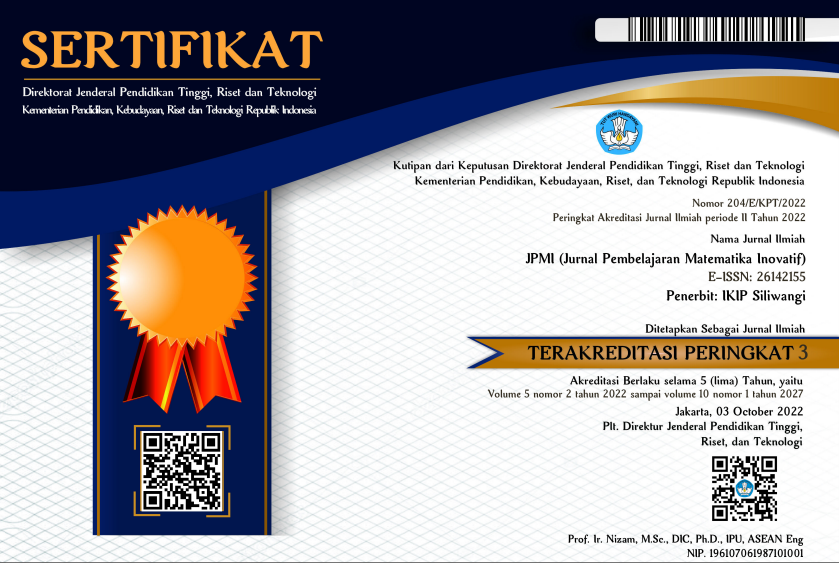Efektivitas self-determination theory dalam perilaku pemecahan masalah matematis siswa
DOI:
https://doi.org/10.22460/jpmi.v6i4.17962Keywords:
Motivation, mathematical problem, self-believe, behavior, problem-solvingAbstract
References
Baars, M., Wijnia, L., & Paas, F. (2017). The association between motivation , affect , and self-regulated learning when solving problems. Frontiers in Psychology, 8, 1346. https://doi.org/10.3389/fpsyg.2017.01346
Bautista, R. G. (2013). The students’ procedural fluency and written-mathematical explanation on constructed response tasks in physics. Journal of Technology and Science Education, 3(1), 49–56. https://doi.org/10.3926/jotse.68
Braithwaite, D. W., & Sprague, L. (2021). Conceptual knowledge, procedural knowledge, and metacognition in routine and nonroutine problem solving. Cognitive Science, 45(10). https://doi.org/10.1111/cogs.13048
Chinofunga, M. D., & Taylor, S. (2022). Procedural flowcharts can enhance senior secondary mathematics. The Annual Meeting of the Mathematics Education Research Group of Australasia (MERGA) (44th, Launceston, Tasmania, Australia, Jul 3-7, 2022), 130–137.
Chiu, T. K. F. (2021). Applying the self-determination theory (SDT) to explain student engagement in online learning during the covid-19 pandemic. Journal of Research on Technology in Education, 0(0), 1–17. https://doi.org/10.1080/15391523.2021.1891998
Dochy, F., Moerkerke, G., & Segers, M. (1999). The effect of prior knowledge on learning in educational practice: Studies using prior knowledge state assessment. Evaluation and Research in Education, 13(3), 114–131. https://doi.org/10.1080/09500799908666952
Handayaningsih, R., & Nusantara, T. (2021). Profil multiple intelligences dalam kemampuan pemecahan masalah matematika. Edu Sains Jurnal Pendidikan Sains & Matematika, 9(1), 20–32. https://doi.org/10.23971/eds.v9i1.1992
Jonassen, D. H. (2009). Learning to solve problems : an instructional design guide. Gifted and Talented Internationa, 24(2), 153–154. https://doi.org/: 10.1080/15332276.2009.11673538
Kurniawan, A., & Kadarisma, G. (2020). Pengaruh disposisi matematis terhadap kemampuan pemecahan masalah matematis siswa. Jurnal Pembelajaran Matematika Inovatif (JPMI), 3(2), 99–108. https://doi.org/10.30822/asimtot.v1i1.97
Latifah, T., & Afriansyah, E. A. (2021). Kesulitan dalam kemampuan pemecahan masalah matematis siswa pada materi statistika. Journal of Authentic Research on Mathematics Education (JARME), 3(2), 134–150.
Maskar, S., Puspaningtyas, N. D., & Puspita, D. (2022). Linguistik matematika: suatu pendekatan untuk meningkatkan kemampuan pemecahan masalah non-rutin secara matematis. Mathema Journal, 4(2), 118–126. www.oecd.org/pisa/,
Morin, S., & Herman, T. (2022). Systematic literature review : keberagaman cara berpikir siswa dalam pemecahan masalah. Jurnal Pembelajaran Matematika Inovatif (JPMI), 5(1), 271–286. https://doi.org/10.22460/jpmi.v5i1.271-286
Muir, T. (2021). Self-determination theory and the flipped classroom: a case study of a senior secondary mathematics class. Mathematics Education Research Journal, 33(3), 569–587. https://doi.org/10.1007/s13394-020-00320-3
Muir, T., Beswick, K., & Williamson, J. (2008). “I’ m not very good at solving problems â€: An exploration of students ’ problem solving behaviours. The Journal of Mathematical Behavior, 27(3), 228–241. https://doi.org/10.1016/j.jmathb.2008.04.003
Mukasyaf, F., Fauzi, K. M. A., & Mukhtar, M. (2019). Building learning trajectory mathematical problem solving ability in circle tangent topic by applying metacognition approach. International Education Studies, 12(2), 109. https://doi.org/10.5539/ies.v12n2p109
Niemiec, C. P., & Ryan, R. M. (2009). Autonomy, competence, and relatedness in the classroom:Applying self-determination theory to educational practice. Theory and Research in Education, 7(2), 133–144. https://doi.org/10.1177/1477878509104318
Pradiarti, R. A., & Subanji. (2022). Mosharafa: jurnal pendidikan matematika kemampuan pemecahan masalah matematis siswa SMP ditinjau dari gaya kognitif. Mosharafa: Jurnal Pendidikan Matematika, 11(3), 379–390. http://journal.institutpendidikan.ac.id/index.php/mosharafa
Rahmatiya, R., & Miatun, A. (2020). Analisis kemampuan pemecahan masalah matematis ditinjau dari resiliensi matematis siswa SMP. Teorema: Teori Dan Riset Matematika, 5(2), 187. https://doi.org/10.25157/teorema.v5i2.3619
Raley, S. K., Shogren, K. A., Rifenbark, G. G., Thomas, K., McDonald, A. F., & Burke, K. M. (2020). Enhancing secondary students’ goal attainment and self-determination in general education mathematics classes using the self-determined learning model of instruction. Advances in Neurodevelopmental Disorders, 4(2), 155–167. https://doi.org/10.1007/s41252-020-00152-z
Reeve, J., Lee, W., & Won, S. (2015). Interest as emotion , as affect , and as schema. In & S. H. K. A. Renninger, M. Nieswandt (Ed.), Interest in mathematics and science learning (pp. 79–92). Washington, DC: American Educational Research Association.
Rittle-Johnson, B. (2017). Developing mathematics knowledge. Child Development Perspectives, 11(3), 184–190. https://doi.org/10.1111/cdep.12229
Ryan, R. M., & Deci, E. L. (2020). Intrinsic and extrinsic motivation from a self-determination theory perspective: Definitions, theory, practices, and future directions. Contemporary Educational Psychology, 61(xxxx), 101860. https://doi.org/10.1016/j.cedpsych.2020.101860
Septianingtyas, N., & Jusra, H. (2020). Kemampuan pemecahan masalah matematis peserta didik berdasarkan adversity quotient. Jurnal Cendekia : Jurnal Pendidikan Matematika, 4(2), 657–672. https://doi.org/10.31004/cendekia.v4i2.263
Steyn, G., & Adendorff, S. A. (2020). Questioning techniques used by foundation phase education students teaching mathematical problem-solving. South African Journal of Childhood Education, 10(1), 1–9. https://doi.org/10.4102/sajce.v10i1.564
Supiarmo, M. G., Mardhiyatirrahmah, L., & Turmudi, T. (2021). Pemberian scaffolding untuk memperbaiki proses berpikir komputasional siswa dalam memecahkan masalah matematika. Jurnal Cendekia : Jurnal Pendidikan Matematika, 5(1), 368–382. https://doi.org/10.31004/cendekia.v5i1.516
Susanti, E., & Faradiba, S. S. (2022). Analisis kemampuan koneksi matematika peserta didik dalam memecahkan masalah matematika berdasarkan metacognitive awereness inventory. Jurnal Cendekia : Jurnal Pendidikan Matematika, 6(2), 1203–1209. https://doi.org/10.31004/cendekia.v6i2.1344
The American Institutes for Research self determination questionarre (AIR Self-determination). (n.d.). https://www.ou.edu/education/centers-and-partnerships/zarrow/self-determination- assessment-tools/air-self-determination-assessment)
Vansteenkiste, M., Soenens, B., Sierens, E., Luyckx, K., & Lens, W. (2009). Motivational profiles from a self-determination perspective : the quality of motivation matters. Journal of Educational Psychology, 101(3), 671–688. https://doi.org/10.1037/a0015083
Yin, R. K. (2018). Case study research and applications: design and methods. In Journal of Hospitality & Tourism Research (Vol. 53, Issue 5). Los Angeles: SAGE Publications, Inc. https://doi.org/10.1177/109634809702100108
Zulkarnaen, R. (2018). Peningkatan kemampuan pemodelan dan penalaran matematis serta academic self-concept siswa SMA melalui interpretation-construction design model. Disertasi, SPs Universitas Pendidikan Indonesia.
Zulkarnaen, R. (2022a). Efektivitas pembelajaran matematika secara daring ditinjau dari self-determination. Jurnal Pembelajaran Matematika Inovatif, 5(2).
Zulkarnaen, R. (2022b). Efektivitas pemmbelajaran Matematika secara daring ditinjau dari self-determination. JPMI (Jurnal Pembelajaran Matematika Inovatif), 5(2), 355. https://doi.org/10.22460/jpmi.v5i2.10244
Zulkarnaen, R., Salsabila, A., Amara, P., Siregar, B., Juliani, D., Herawaty, D. P., Gustiani, D., Salsaprilia, H., Ismail, Louhenapessy, L. Y., Cahyani, S. R., & Aliya, V. (2021). LKS matematika bagi siswa kelas VIII (theory of didactical situation dalam pembelajaran matematika). Tasikmalaya, Indonesia: Perkumpulan Rumah Cemerlang Indonesia.

















